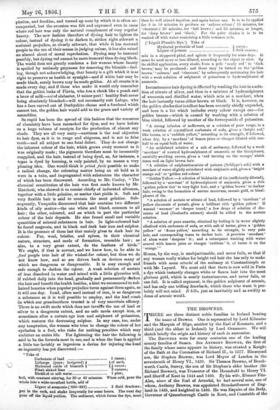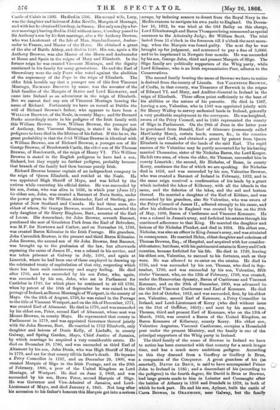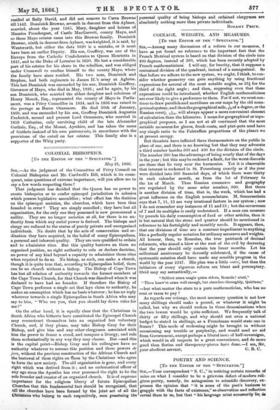THE BROWNES.
THERE are three distinct noble families in Ireland bearing the name of Browne. One is represented by Lord Kilmaine and the Marquis of Sligo, another by the Earl of Kenmore, and a third (and the oldest in Ireland) by Lord Oran.more. We will sketch briefly the origin and history of each in succession.
The BROWNE8 were for many centuries one of the leading county families of Sussex. Six ANTHONY BROWNE, the first of the family whose name appears in history, was created a Knight of the Bath at the Coronation of Richard II., in 1377. His second son, Sir Stephen Browne, was Lord Mayor of London in. the seventeenth of Henry VI., 1439. Sir Thomas Browne, of Beech- worth Castle, Surrey, the son of Sir Stephen's elder brother (Sir Richard Browne), was Treasurer of the Household to Henry VI. and Sheriff of Kent in 1414 and 1460. By his wife, Eleanor Fitz- Alen, niece of the Earl of Arundel, he had several sons, one of whom, Anthony Browne, was appointed Standardbearer of Eng- land in 1485, and knighted in 1486. He was Esquire of the Body, Governor of Queenborough Castle in Kent, and Constable of the Castle of Calais in 1503. He died in 1506. His second wife, Lucy, was the daughter and heiress of John Neville, Marquis of Montagu, and with her he obtained Cowdray, in Sussex. Her only son (by a for- mer marriage) having died in 1542 without issue, Cowdray passed to Sir Anthony's son by his first marriage, also a Sir Anthony Browne, who was Lieutenant of the Isle of Man, Standardbearer, Ambas- sador to France, and Master of the Horse. Ile obtained a grant of the site of Battle Abbey, and died in 1548. His son, again a Sir Anthony Browne, was also Master of. the Horse and Ambassador at Rome and Spain in the reigns of Miry and Elizabeth. In the former reign he was created Viscount Montagu, and the dignity continued in his family for many generations. He and the Earl of Shrewsbury were the only Peers who voted against the abolition of the supremacy of the Pope in the reign of Elizabeth. The older Irish heralds say that a younger son of this first Viscount Montagu, RICHARD BROWNE by -name, was the ancestor of the Irish families of the Marquis of Silo° and Lord KILMAINE, and came into Ireland as an adventurer in the reign of Elizabeth. But we cannot find any son of Viscount Montagu bearing the name of Richard. Fortunately we have on record at Dublin the will of Richard Browne's father, who appears to have been a WILLIAM BnowNE, of the Neale, in county Mayo; and Sir Bernard Burke accordingly starts in his pedigree of the Irish family with this William Browne. Now, William Browne, the younger son of Anthony, first Viscount Montagu, is stated in the English pedigrees to have died in the lifetime of his father. If this be so, the great probability is that the Irish William Browne is identical with a William Browne, son of Richard Browne, a younger son of Sir George Browne, of Beechworth Castle, the eldest son of Sir Thomas Browne, of Beechworth, of the reign of Henry VI. This William Browne is stated in the English pedigrees to have had a son, Richard, but they supply no further pedigree, probably because that branch of the family had then become purely Irish.
Richard Browne became captain of an independent company in the reign of Queen Elizabeth, and resided at the Neale. He was appointed High Sheriff of Mayo, and was killed by the natives while executing his official duties. He was succeeded by his son, Josias, who was alive in 1636, in which year (June 17) his eldest son, John, was created a Baronet of Nova Scotia, under the power given to Sir William Alexander, Earl of Sterling, pro- prietor of New Scotland and Canada. He had three sons, the eldest of whom, Sir George Browne, second Baronet, married the only daughter of Sir Harry Bingham, Bart., ancestor of the Earl of Lucan. His descendant, Sir John Browne, seventh Baronet, purchased the seat of Graulston Park from the Earl of Belvedere, was M.P. for Newtown and Carlow, and on November 16, 1789, was created Baron Kilmaine in the Irish Peerage. His grandson, John Cavendish Browne, is the present and third Baron Kilmaine. John Browne, the second son of Sir John Browne, first Baronet, was brought up to the profession of the law, but afterwards espousing the cause of James II., was a colonel in his service, and was taken prisoner at Galway in July, 1691, and again at Limerick, where he had been one of those employed in drawing up the celebrated treaty of capitulation of that city, respecting which there has been such controversy and angry feeling. He died after 1705, and was succeeded by his son Peter, who, again, was succeeded by his son, John, who sat in Parliament for Castlebar in 1749, for which place he continued to sit till 1760, when by patent of the 10th of September he was raised to the peerage of Ireland, as Baron Monteagle of Westport, in the county of Mayo. On the 24th of August, 1768, he was raised in the Peerage to the title of Viscount Westport, and on the 4th of December, 1771, was created Earl of Altamont. He died in 1776, and was succeeded by his eldest son, Peter, second Earl of Altamont, whose seat was Mount-Browne, in county Mayo. He represented that county in Parliament in 1779, and was appointed Governor thereof jointly with Sir John Browne, Bart. He married in 1752 Elizabeth, only daughter and heiress of Denis Kelly, of Lisduffe, in county Galway, and Spring Garden, Mayo, Chief Justice of Jamaica, by which marriage he acquired a very considerable estate. He died on December 28, 1780, and was succeeded as third Earl of Altamont by his son, John Denis, who was High Sheriff of Mayo in 1779, and sat for that county till his father's death. He became a Privy Councillor in 1787, and on December 29, 1800, was created Marquis of Sligo in the Irish Peerage, and on the 20th of February, 1806, a peer of the United Kingdom as Lord Montagu, of Westport. He died on June 2, 1809, and was succeeded by his son, Howe Peter, second Marquis of Sligo. He was Governor and Vice-Admiral of Jamaica, and Lord- Lieutenant of Mayo, and died January 4, 1845. Not long after his accession to his father's honours this Marquis got into a serious
scrape, by inducing seamen to desert from the Royal Navy in the Mediterranean to navigate his own yacht to England. On Decem- ber 16, 1812, he was tried at the Old Bailey on this charge, Lord Ellenborough and Baron Thompson being summoned as special assessors to the Admiralty Judge, Sir William Scott. The trial lasted from 11 o'clock in the forenoon till 2 o'clock the next morn- ing, when the Marquis was found guilty. The next day he was brought up for judgment, and sentenced to pay a fine of 5,000/. and to be imprisoned in Newgate four months. He was succeeded by his son, George John, third and present Marquis of Sligo. The Sligo family are politically supporters of the Whig party, while Lord Kilmaine, who is an Irish representative Peer, adheres to the Conservatives.
The second family bearing the name of Browne we have to notice is derived from the county of Lincoln. SIR VALENTINE BROWNE, of Crofta, in that county, was Treasurer of Berwick in the reigns of Edward VI. and Mary, and Auditor-General in Ireland in the reign of Elizabeth. These offices point sufficiently to the bent of his abilities or the nature of his pursuits. He died in 1567, leaving a son, Valentine, who in 1583 was appointed jointly with Sir Henry Wallop to survey escheated lands in Ireland, generally a very profitable employment to the surveyors. He was knighted, sworn of the Privy Council, and in 1585 represented the county of Sligo in Parliament. On the 28th of June in the latter year he purchased from Donald, Earl of Glencare (commonly called MacCarthy More), certain lands, manors, &c., in the counties of Kerry and Cork, and obtained a grant by patent from Queen Elizabeth in remainder of the lands of the said Earl. The rapid success of Sir Valentine may be partly accounted for by his having married Thomazine, sister of Sir Nicholas Baron, the Lord Keeper. He left two sons, of whom the elder, Sir Thomas, succeeded him in county Limerick ; the second, Sir Nicholas, of Rosse, in county Kerry, continues the line of which we are speaking. Sir Nicholas. died in 1616, and was succeeded by his son, Valentine Browne, who was created a Baronet of Ireland in February, 1622, and in the same reign received a confirmation of his lands by a grant which included the lakes of Kilkenny, with all the islands in the same, and the fisheries of the lakes, and the soil and bottom thereof. He married a daughter of the Earl of Kildare, and was succeeded by his grandson, also Sir Valentine, who was sworn of the Privy Council of James H., adhered strongly to his cause, and after his abdication in England was created by him on the 20th of May, 1689, Baron of Castlerosse and Viscount Kenmare. He was a colonel in James's army, and forfeited his estates through his continued adherence to that King. He married the daughter and heiress of Sir Nicholas Plunket, and died in 1694. His eldest son,. Nicholas, was also an officer in King James's army, and was attainted in consequence. He married Helen, eldest daughter and coheiress of Thomas Browne, Esq., of Hospital, and acquired with her consider- able estates; but these, with his patrimonial estates in Kerry and Cork counties, became forfeited for his life. He died in 1720, leaving his eldest son, Valentine, to succeed to his fortunes, such as they were. He was allowed to re-enter on the estates. He died in 1736, and was succeeded by his son, Thomas, who died in Sep- tember, 1790, and was succeeded by his son, Valentine, fifth titular Viscount, who, on the 12th of February, 1798, was created, under the Hanoverian dynasty, Baron of Castlerosse and Viscount Kenmare, and on the 29th of December, 1800, was advanced to. the titles of Viscount Castlerosse and Earl of Kenmare. He died on the 3rd of October, 1812, and was succeeded, first, by his eldest son, Valentine, second Earl of Kenmare, a Privy Councillor in Ireland, and Lord-Lieutenant Of Kerry (who died without issue on the 31st of October, 1853) ; and next by his second son, Thomas, third and present Earl of Kenmare, who on the 12th of March, 1856, was created a Baron of the United Kingdom, as. Baron Kenmare of Killarney, county Kerry. His eldest son, Valentine Augustus, Viscount Castlerosse, occupies a Household, post under the present Ministry, and the family is one of the principal supporters of the Whig party in Ireland.
The third family of the name of Browne in Ireland we have to notice has been connected with that country for a much longer time, and has a much more ambitious pedigree. According to this they descend from a Geoffrey or Godfrey le Brun, a companion of the Conqueror. A great grandson of his (as asserted), DAVID LE BRUN, is said to have accompanied Prince John to Ireland in 1185; and a descendant of his (according to the pedigree) in the fourth degree, Sir David le Brun or Browne, had large grants made to him in Leinster and Connaught after the battles of Athenry in 1316 and Dundalk in 1318, in both of which he took part. He and his son, Aylmer, built the castle of Carra Browne, in ORANMORE, near Galway, but the family
melded at Bally David, and did not remove to Cerra Browne till 1442. Dominick Browne, seventh in descent from this Aylmer, married, about the year 1565, Mary, daughter and heiress of Maurice Prendergast, of Castle MacGarrett, county Mayo, and so these Mayo estates came into this Browne family. Dominick Browne, ninth in descent from Aylmer, was knighted, it is said, by Wentworth, but either the date 1620 is a mistake, or it must have been an earlier Deputy. His son, Geoffrey, was one of the Envoys from the Catholic Confederates to Queen Henrietta in 1647, and to the Duke of Lorraine in 1650. He lost a considerable part of his estates for his share in the rebellion, and was obliged under Cromwell to confine himself to the county Mayo, where the family have since resided. His two sons, Dominick and Stephen, had both regiments in James army at Aghrim. This last Dominick was succeeded by his son, Dominick Geoffrey, Governor of Mayo, who died in May, 1826; and he again, by his son Dominick, who married the eldest daughter and coheiress of Henry Monck, Esq., represented the county of Mayo in Parlia- ment, was a Privy Councillor in 1834, and in 1836 was raised to the peerage as Baron Oranmore. He died 30th of January, 1860, and was succeeded by his son, Geoffrey Dominick Augustus Frederick, second and present Lord Oranmore, who married in 1859 Catherine, only surviving child of the late Alexander Guthrie, Esq., of the Mount, Ayrshire, and has taken the name of Guthrie instead of his own patronymic, in accordance with the provisions of the entail on her estates: This family also is a supporter of the Whig party.
































 Previous page
Previous page